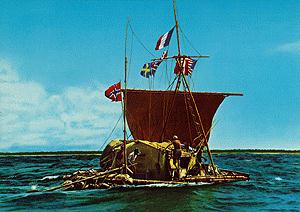The National NC-173 is a post-war (1947) general coverage Broadcast, HF and 6-meter receiver. It cost $189.50 new with speaker. The bandspread tuning dial is calibrated for the ham bands. The NC-173 accompanied the Thor Heyerdahl "Kon-Tiki" expedition according to an ad by National (see below) run in Radio-News (10-47) as well as in QST. The expedition used dry batteries for power. In checking power requirements for this receiver, I was a bit surprised that they could run it on batteries. However, other than the filament requirements, I found I could still get speaker volume on international short-wave broadcasts with as little as 35 to 40 volts of B+ supplied externally. The receiver's current draw at 35 volts of B+ was only about 11 milliamps. I am sure this can be done with other receivers of this type, but reading the ad aroused my curiosity and I was a bit amazed by the result. In reading about the expedition in the 12-47 issue of QST, it was the filament requirements for this receiver which became a problem. Some of the "B" batteries were opened to supply the filament power.
Since doing this experiment, I have found a letter ad from National in the February, 1942 QST indicating the current for various B+ voltages when the National NC-200, the HRO, and a couple of other sets are run from battery power in an emergency. The ad was in response to possible emergencies coincident with the US entry into World War II.
In his book "Kon-Tiki" (Rand-McNally 1950, p. 263), Heyerdahl describes the NC-173 slowly drying out on an uninhabited South Sea island after getting soaked in the shipwreck of the Kon-Tiki, gradually receiving at higher and higher frequencies towards the ham band segment they needed for their contact (13.990 MHz was mentioned earlier in the book). They finally managed to send an "all well, all well" to their ham contacts so as to avoid a massive rescue attempt.
Heyerdahl writes, "We set about putting together the soaked radio apparatus; we must do it quickly so that Torstein and Knut might get on the air before the man on Rarotonga sent out a report of our sad end."... "Coils and radio parts lay drying in the tropical sun on slabs of coral. .. The whole day passed and the atmosphere grew more and more hectic. The rest of us ... crowded round the radio in the hope of being able to give assistance. We must be on the air before 10 P.M. Then the thirty-six hours' time limit would be up, and the radio amateur on Rarotonga would send out appeals for airplane and relief expeditions. ... Seven o'clock, eight, nine. The tension was at the breaking point. Not a sign of life in the transmitter, but the receiver, an NC-173, began to liven up somewhere at the bottom of the scale and we heard faint music. But not on the amateur wavelength. It was eating its way up; perhaps it was a wet coil that was drying inward from one end. ... The transmitter was as dumb as ever, but the receiver was sputtering upward toward the right wave length. Suddenly it crackled on the Rarotonga man's frequency."
Heyerdahl continued the story. They were finally able to get their small back-up transmitter powered by a hand-cranked generator to function and sent the "All well" message from LI2B. The small back-up transmitter was a British Mark II "spy set" from World War II. A picture of the equipment in use on the island appears in Heyerdahl's book. The hand-cranked generator pictured appears to be a U.S. Military Signal Corps GN-45 or 58.
